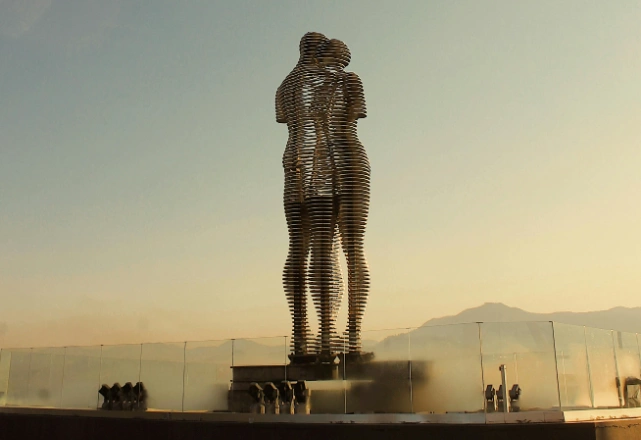Ali and Nino: A Moving Symbol of Love in Batumi
On Batumi’s vibrant seaside boulevard, one of the most captivating sights is not just the Black Sea horizon but the breathtaking kinetic sculpture of Ali and Nino. Towering at 8 meters tall, these two steel figures, designed by Georgian artist Tamar Kvesitadze, tell a powerful story of love, separation, and eternal return.

The Story Behind the Sculpture
The figures represent Ali, a Muslim boy from Azerbaijan, and Nino, a Christian girl from Georgia, the protagonists of Kurban Said’s 1937 novel Ali and Nino. Their love story unfolds against the backdrop of war, cultural differences, and political upheaval in the early 20th century Caucasus.
Every evening in Batumi, visitors watch in awe as the two figures glide slowly toward each other, merge into one, and then separate again — a poetic reminder of love’s triumph and tragedy. This graceful movement, lasting about 10 minutes, draws travelers from around the world who stand silently as the story comes alive in steel and light.
Batumi’s Symbol of Unity
Beyond its romantic tale, Ali and Nino symbolize the eternal bond between cultures and the resilience of human connection. Batumi, with its mix of European, Ottoman, and Georgian influences, couldn’t be a more fitting home for such a work of art. At night, the figures illuminate, casting shimmering reflections across the sea — a must-see moment for every visitor.
A Georgia That Welcomes the World
Just as Ali and Nino unite cultures in a dance of love, Georgia itself continues to open its arms to the world. In 2025, Tbilisi will host the Junior Eurovision Song Contest, showcasing young talents and uniting nations through music. Together with Batumi’s romantic landmark, it highlights Georgia as a country where tradition, love, and creativity meet the modern global stage.
Votes: https://crowch.com/vote/2907/statistic/https://crowch.com/vote/2895/statistic/ https://crowch.com/vote/2919/statistic/
Close